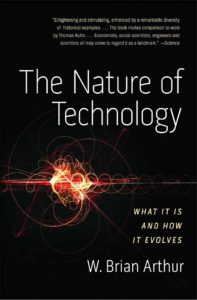Between 2008 and 2011, I wrote several brief reviews of books which appeared on the Education Review web site. Since then, the editors ceased publication of that type of review and removed the previously published brief reviews from the site. I am making the original drafts of my reviews available here.
Brief Review of Arthur, B. (2009). The nature of technology: What it is and how it evolves. New York: Free Press..
By Dr. Gary L. Ackerman, January 2010
 Ostensibly, The Nature of Technology is not a book that one would predict would be of high interest for educators. The author, W. Brian Arthur, is an economist and complexity scientist, and a quote in the biographic sketch on the dust jacket claims his ideas account for hundreds of millions of dollars worth of transactions daily. On closer look, however, the book should be read by those who seek to understand education as a human invention and also those who seek to use technology to transform pedagogy in any classroom.
Ostensibly, The Nature of Technology is not a book that one would predict would be of high interest for educators. The author, W. Brian Arthur, is an economist and complexity scientist, and a quote in the biographic sketch on the dust jacket claims his ideas account for hundreds of millions of dollars worth of transactions daily. On closer look, however, the book should be read by those who seek to understand education as a human invention and also those who seek to use technology to transform pedagogy in any classroom.
Arthur begins with the observation that the rich literature describing the history of technology and the applications of technology to human society and culture is missing a general theory describing the origins and evolution of that technology. To help readers understand how humans create technologies in attempts to solve human problems, Arthur identifies three themes that are well-developed in the first several chapters: (a) technologies exist on different levels; (b) at each level, a technology is made of other technologies, so technology is recursive; and (c) technologies exploit natural phenomena. Further, Arthur differentiates conventional technologies (devices that are built by humans) from non-conventional technologies (such monetary systems). Both types of technologies are described in terms of the common elements of design for a human purpose that exploits phenomena in recursive elements.
Although Arthur mostly uses examples from conventional engineering to illustrate the principles of technology, the reflective reader will recognize education as a non-conventional technology. Different interpretations of education as a non-conventional technology can be supported, but education is designed for the purpose of preparing individuals for life in society and it is achieved by designing environments in which learning can occur (the details and success of those environments is debated) and those environments are designed on many levels with recursive elements. Educators’ reluctance to perceive their craft as a technology may be one reason this book will not end up on the reading lists of many educators.
In the second part of the book, Arthur explains how technologies originate and how technologies can become building blocks for what he describes as “structural deepening” that leads to “adaptive stretching” and “revolutions and redomaining.” These phrases may be another reason this book does not make the reading lists of educators, but Arthur gives readable and reasoned explanations with equally readable and interesting examples. Despite this, the two chapters dealing with economics almost made me put the book away before I reached the end, but the last chapter brings importance of the book for educators into full light.
In the final chapter, Arthur considers the question “Where do we stand with this creation of ours?” and he recognizes the stress that technology can cause for individuals, institutions, and society. In the final paragraph, Arthur argues that humans must be proponents of technology that supports interaction that gives meaning and purpose to life, as opposed to technology that only contributes to economic life. It is important that educators understand this conclusion and Arthur’s view of technology supporting this conclusion. The impact of modern technology on education is inevitable, and many are questioning the relevance of educators who ignore technology. Arthur gives us a reasoned framework for understanding our practice as a technology and for redesigning our practice as a technology. He also gives us a much-needed humane view of technology.